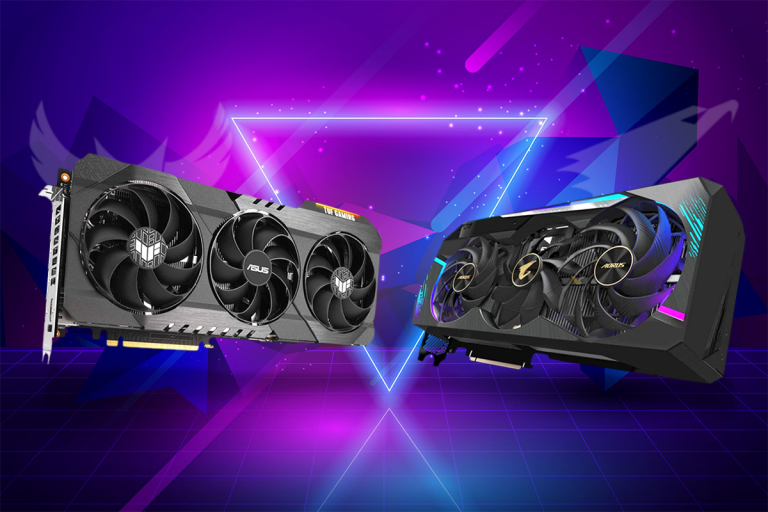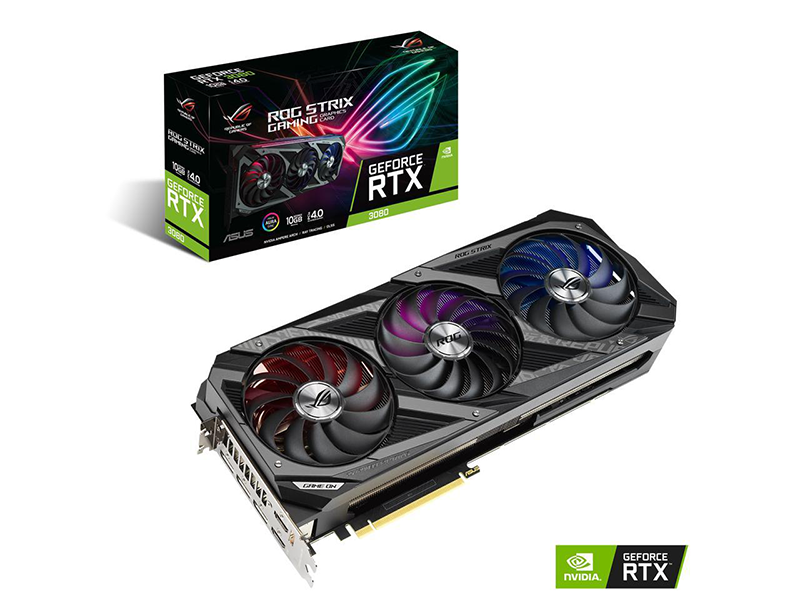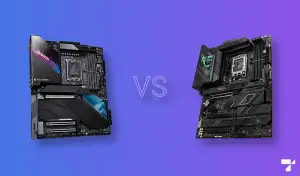The RTX 3080 graphics card powered by Nvidia’s latest Ampere architecture has arrived. It boasts of significant performance gains over the previous generation of Turing cards, even managing to beat the 2080 Ti by about 50% in some games. But what is perhaps the best feature of the RTX 3080 card, is its excellent price to performance ratio when compared to the RTX 2000 series. Coming in at “just” $699 for the Founder’s Edition, considering it beats the $1200 2080 Ti card in performance. Therefore, we have created this comprehensive review of the best RTX 3080 graphics cards.
Moreover, the RTX 3080 provides several new features, including 2nd Gen RT cores for better ray-tracing, and 3rd Gen Tensor cores for better DLSS performance. This card will also run off a staggering 320 watts, for which Nvidia recommends at least a 750W PSU, which is understandable considering the performance gains. If you are interested in picking one up, consider going through this handy guide to find out which are the best RTX 3080 cards to buy.
 Comparison table of the Best RTX 3080 Graphics Cards
Comparison table of the Best RTX 3080 Graphics Cards
|
1
EVGA RTX 3080 FTW3 Ultra Gaming
|
Features:
|
Specs:
|
Check Price |
|
2
Aorus RTX 3080 Master
|
Features:
|
Specs:
|
Check Price |
|
3
ASUS ROG Strix RTX 3080
|
Features:
|
Specs:
|
Check Price |
|
4
ASUS TUF Gaming RTX 3080
|
Features:
|
Specs:
|
Check Price |
|
5
Aorus RTX 3080 Xtreme
|
Features:
|
Specs:
|
Check Price |
|
6
MSI RTX 3080 Gaming X Trio
|
Features:
|
Specs:
|
Check Price |
|
7
Gigabyte RTX 3080 Eagle OC
|
Features:
|
Specs:
|
Check Price |
|
8
ZOTAC GAMING RTX 3080 Trinity
|
Features:
|
Specs:
|
Check Price |
|
9
PNY RTX 3080 XLR8 Triple Fan
|
Features:
|
Specs:
|
Check Price |
|
10
EVGA RTX 3080 XC3 Ultra
|
Features:
|
Specs:
|
Check Price |
10 Best RTX 3080 Graphics Cards
1. EVGA RTX 3080 FTW3 Ultra Gaming
Stream Processors: 8,704 | Base/Boost Clock: 1800 MHz/2375 MHz | Memory: 10 GB GDDR6X | Memory Clock: 19Gbps | Power Connectors: 3x PCIe 8-pin | Outputs: HDMI 2.1, 3x DisplayPort 1.4a
EVGA’s flagship, the FTW3 Ultra Gaming, is a beefed-up RTX 3080 that features an overhauled cooling solution, excellent RGB lighting, and more. Performance-wise, the graphic card will most certainly be able to handle longer boost clocks, and for those out there looking get the best out of the card, the Precision X1 software by EVGA will let you do just that through its advanced overclocking features.
EVGA’s iCX3 technology provides an excellent cooling solution for the graphics card through the intelligent use of temperature sensors to actively regulate the fan speeds to provide proper airflow. Also, the fans feature optimization for noise reduction and will stop for temperatures below 55°C. All these features combined make the iCX3 one of the best cooling solutions for RTX 3080.
The FTW3 Gaming Ultra also is quite big with a length of 300mm and a 2.75 slot width, and considering the cooling solution EVGA has in place, it does not seem that surprising. The backplate also features a unique honeycomb structure for efficient airflow through the back of the card.
Like other board partners, EVGA also has decided to go for three 8-pin PCIe connectors to supply power to the GPU, which will also allow for a decent overclocking headroom since the card is known to sip 320 watts on heavy loads. As for lighting, the card features a large strip on the top, which features an adjustable ARGB LED.
The EVGA FTW3 Ultra Gaming RTX 3080 is another example of a custom design that provides a significant amount of features to make the card worth it’s the higher cost compared to the competition and is a good buy if you are looking forward to overclocking the card. Also, keep in mind the different number of power connectors and the GPU size for your build’s compatibility.
2. Aorus RTX 3080 Master
Stream Processors: 8,704 | Base/Boost Clock: 1440 MHz/1845 MHz | Memory: 10 GB GDDR6X | Memory Clock: 19Gbps | Power Connectors: 2x PCIe 8-pin | Outputs: 3x HDMI 2.1, 3x DisplayPort 1.4a
The Aorus Master from Gigabyte is a capable RTX 3080 graphics card with the added advantage of an excellent cooling solution, which will net you performance gains in terms of overclocking and longer duration boost clocks. However, for best results overclocking, software like MSI’s Afterburner would be a better choice for most users.
Gigabyte completely redesigned their colling solution and have made use of ingenious solutions to keep the temperatures down. Starting with the fan design, we notice that the three fans slightly overlap each other, with the central fan spinning in the opposite direction to the other two. Gigabyte claims that this reduces turbulence, which, in turn, allows for higher pressure and smoother airflow.
The heatsink extends beyond the motherboard, allowing for more airflow and the angular fin design for a larger surface area for heat dissipation. Also, below the fans are ‘wind claws’ that claims to improve the heatsink’s airflow. Overall, the cooling system seems impressive, and you should expect temperatures to be lower.
The card comes with two 8-pin PCIe connectors, which should not come in the way of performance gains by a lot, although lesser than other offerings. Similar to other RTX 3080’s, the fans on this GPU will turn off when idle or on low loads, significantly reducing system noise. The RGB lighting on the card is minimal and works with Gigabyte’s RGB Fusion. There is also an LED indicator that notes the internal temperature of the GPU. You also receive two additional HDMI 2.1 ports for hooking up more monitors that support the spec.
The Arous Master RTX 3080 delivers significant perks for a custom design. Although it does only include two power connectors, it still makes up by offering an excellent cooling solution. With a length of 31.9 cm, it certainly makes up for a large card, so make sure you have a compatible case before you pick one up.
3. ASUS ROG Strix GeForce RTX 3080
Stream Processors: 8,704 | Base/Boost Clock: 1740 MHz/2348 MHz | Memory: 10 GB GDDR6X | Memory Clock: 19Gbps | Power Connectors: 3x PCIe 8-pin | Outputs: 2x HDMI 2.1, 3x DisplayPort 1.4a
Asus’s ROG Strix RTX 3080 has the bells and whistles you would expect from a premium custom version of the RTX 3080. With a redesigned body, massive cooling system, and advanced software support, you get one of the best performing RTX 3080 out there yet with an out-of-the-box boost clock of 1740 MHz.
Asus has decided to redesign the fan layout by increasing the number of fins and slimming down the fan rings to increase the heatsink’s airflow. The central fan’s direction has also seen a reversal, which would allow for less turbulence, allowing for better thermal performance.
A wider 2.9 slot heatsink design coupled with a smoother heat spreader provides for better heat dissipation. All these thermal improvements will enable the card to run without fans at lower workloads, reducing the system noise significantly.
An interesting addition to the card is the presence of two PWM fan connectors, which allow you to hook up two chassis fans to the GPU for better control and reachability. The GPU also requires 3 PCIe 8-pin connectors to run, convenient for those looking to push the card beyond its stock settings. An additional HDMI port comes in at the back, letting you use the GPU with a dual monitor setup that supports the HDMI 2.1 spec.
The card includes a front RGB element that works with Asus’s Armoury Crate. An LED indicator for indicating power supply issues is also present for easier troubleshooting. The card is pretty sizeable, measuring 31.85 cm across its length, and it’s best to check for compatibility before buying this card.
Overall, though, the ROG Strix RTX 3080 makes one of the best 3rd party cards out there in the market, though at a significant price premium. With the beastly cooling solution, you can expect the GPU to respond well to overclocking and extended boost periods.
4. ASUS TUF Gaming RTX 3080
Stream Processors: 8,704 | Base/Boost Clock: 1740 MHz/2348 MHz | Memory: 10 GB GDDR6X | Memory Clock: 19Gbps | Power Connectors: 2x PCIe 8-pin | Outputs: 2x HDMI 2.1, 3x DisplayPort 1.4a
The TUF brand is well known to be Asus’s mid-range offering. But for the RTX 3080, the difference between brands comes down to minuscule performance gains over the other. The TUF Gaming RTX 3080 is a strong performer with an effective cooling solution and excellent build quality.
Starting with the fans, we notice the improved design and the alternate fan rotation that reduces turbulence, leading to a better pressure buildup and smoother airflow. The fans also stop spinning when the GPU idles or is under a light load, ensuring lower noise and longer-lasting fans.
The massive 2.7-slot wide heatsink features a precision-machined heat spreader and extensive heat pipe network to ensure proper heat dissipation and lower temperatures.
The all-aluminum shroud and backplate lend a premium aesthetic to the card while adding rigidity and conducting heat away from the GPU’s core. A vent is also present on the back to prevent the hot air from being recirculated. The card also features an RGB logo that can sync with ASUS’s AuraSync.
The card gets its power through two 8-pin PCIe power connectors, and it also features an LED that will light up in case of power supply issues. There is also a DualBIOS option, which will let you fine-tune the device without software. For those looking for a dual monitor setup, the extra HDMI port on the back will just let you do that and is great if you can make use of the HDMI 2.1 spec. The Asus TUF RTX 3080 provides a significant increase in performance over the Founder’s Edition with boost clocks of 1785 MHz. It is an excellent option for those looking for a card that offers some overclocking with low temperatures at a reasonable price.
5. AORUS RTX 3080 XTREME
Stream Processors: 8,704 | Base/Boost Clock: 1,440 MHz/1,905 MHz | Memory: 10 GB GDDR6X | Memory Clock: 19Gbps | Power Connectors: 3x PCIe 8-pin | Outputs: 3x HDMI 2.1, 3x DisplayPort 1.4a
The Arous Xtreme is Gigabyte’s toned up version of the RTX 3080, offering a substantial amount of cooling coupled with an improved design. Expect this card to have a significant amount of overclocking headroom and stay at much lower temperatures when under load.
The card comes with Gigabyte’s new fan technology that includes three fans overlapping by a small margin near the edges, allowing them to push air through the heatsink’s entirety. The central fan also spins in the opposite direction to the peripheral fans reducing the turbulence and allowing for smoother airflow channeled with a wind claw setup below the fans.
The heatsink also extends beyond the PCB allowing for better cooling and features an angular fin design to help get rid of the heat faster. All these cooling solutions work together to help keep the system cool enough that the fans don’t even need to run on idle or light workloads, reducing system noise. The two extra HDMI 2.1 ports on the back will allow you to add even more monitors through an HDMI cable if they support the spec.
The GPU will need three PCIe 8-pin connectors, considering the amount of power required to achieve this performance level and allows for a fair amount of overclocking above the power limit. RGB lighting on the card operates with Gigabyte’s RGB Fusion, while for overclocking software like MSI’s Afterburner should come in handy. The card also includes a LED that displays the temperature.
The Aorus Master Extreme RRTX 3080 is the right choice for a strong overclocker since the cooling system, and power configuration can bear the load. However, the size of the card might only be viable for some builds.
6. MSI RTX 3080 Gaming X Trio
Stream Processors: 8,704 | Base/Boost Clock: 1815 MHz/2375 MHz | Memory: 10 GB GDDR6X | Memory Clock: 19Gbps | Power Connectors: 3x PCIe 8-pin | Outputs: HDMI 2.1, 3x DisplayPort 1.4a
The RTX 3080 Gaming X Trio is a custom card from MSI that brings a new design, improved thermals, and a small performance bump over Nvidia’s Founder Edition 3080. Performance improvements include a boost clock of 1815 MHz, a small increment over base speeds, while the memory clocks remain at stock. MSI’s Afterburner software will let you tweak the clocks, even more, to get some performance gains for the enthusiasts out there.
The Gaming X Trio improves on Nvidia’s reference design with MSI’s new Tri Frozr 2 cooling system, which consists of a dual-linked fan for improved airflow, massive heatsinks with deflectors for a larger surface area, and five precision machined heat pipes for better contact. Also included are a high number of cooling pads and a graphene backplate to keep components even cooler.
The graphics card is a behemoth, coming in at a length of 32.3 cm and a weight of 1.5 kg, even causing MSI to include an additional GPU support bracket in the box to support the card and prevent excessive sag. The card also makes improvements to keep the noise low by tweaking the cooling system and not running the fans on idle.
MSI also went around the problem of the RTX 3080’s high power draw by including three PCIe 8-pin connector slots on the card, which goes to show how much power it will consume. The RGB on the card is just enough with a few lights in the fan area, a light-up MSI logo, and a strip on the backplate, which syncs with MSI’s Mystic Light system.
The MSI Gaming X Trio manages to push what the RTX 3080 can do by using an excellent cooling solution, providing performance gains that make it worth the price premium and making it one of the best custom cards out there. However, keep in mind that the card’s large form factor might hinder buyers with a smaller case.
7. Gigabyte RTX 3080 Eagle OC
Stream Processors: 8,704 | Base/Boost Clock: 1,440 MHz/1,755 MHz | Memory: 10 GB GDDR6X | Memory Clock: 19Gbps | Power Connectors: 2x PCIe 8-pin | Outputs: 2x HDMI 2.1, 3x DisplayPort 1.4a
Gigabyte’s Eagle OC RTX 3080 is an excellent GPU since it manages to provide a slight bump in performance over the Founder’s Edtion RTX 3080 while managing to come in at the same price. Though its cooling solution may not be up to the standards of the more premium RTX 3080’s, it still does the job well when the card runs at stock settings.
The triple-fan cooling system consists of an alternate spinning configuration, which should reduce the turbulence and lead to smooth airflow through the heatsink. The large copper plating should also keep the core and memory temperatures lower, while the extended heatsink design should allow for better airflow.
When idle or own lighter loads, the GPU fans should stop spinning to ensure a lower noise and lasting fans. The large metal backplate should help with rigidity and help in conducting heat away from the card. The two 8-pin power connectors should be able to power the GPU well.
Gigabyte also increased the power consumption of the card by 20W to allow for performance improvement. The card comes in at 32 cm long, which is relatively large by today’s standards and will surely need a large, well-ventilated case. The GPU includes a minimal amount of RGB accents controlled through the RGB Fusion software. The extra HDMI port might come handy in a dual monitor setup, especially if your monitors are running at 4K 120Hz and support the HDMI 2.1 spec.
Although not as fancy as the more premium cards, the Eagle OC RTX 3080 does the job well and is one of the best options for people looking to get the best RTX 3080 at the base MSRP, considering the performance gains through overclocking this card.
8. ZOTAC GAMING RTX 3080 Trinity
Stream Processors: 8,704 | Base/Boost Clock: 1710 MHz/2375 MHz | Memory: 10 GB GDDR6X | Memory Clock: 19Gbps | Power Connectors: 2x PCIe 8-pin | Outputs: HDMI 2.1, 3x DisplayPort 1.4a
Zotac’s Gaming RTX 3080 Trinity provides a durable all-metal chassis, and advanced cooling system, unique among the increasing premium GPU’s coming with plastic frames and bodies. It also manages to deliver a performance similar to the founder’s edition with a boost clock of 1710 MHz.
The IceStorm 2.0 cooling system comes equipped with an 11-blade fan design that features active fan control that regulates the airflow as per need. The aluminum heatsink comes included with seven copper heat pipes that effectively transfer heat throughout the system. The cooling system is even capable of handling the GPU running at idle or light loads without the fans’ need, reducing the noise significantly.
An all-metal backplate and front plate ensures rigidity and also aid in the heat dissipation. The card employs two 8-pin power connectors to power the card, running the card great at stock and allowing for some overclocking. RGB is minimal and includes an ARGB led which works with Zotac’s Spectra 2.0. Zotac’s FireStorm utility can come in handy for fine-tuning the card to gain the maximum performance. However, some users might prefer the ease and convenience of popular overclocking software like EVGA’s Precision X1.
With a 2.5 slot design and 318 mm length, the card will surely need a large case, especially with good airflow, and is one of the best options available for those looking for a card similar to the Nvidia’s RTX 3080, but with a better aesthetic and some overclocking potential.
9. PNY RTX 3080 XLR8 Triple Fan
Stream Processors: 8,704 | Base/Boost Clock: 1710 MHz/2375 MHz | Memory: 10 GB GDDR6X | Memory Clock: 19Gbps | Power Connectors: 2x PCIe 8-pin | Outputs: HDMI 2.1, 3x DisplayPort 1.4a
PNY’s XLR8 Triple Fan, unlike other offerings on this list, offers a toned-down version of the RTX 3080 with a configuration identical to the founder’s edition, but still manages to provide a decent amount of features for the price.
The triple-fan system features three identical fans with a glossy translucent finish, to ensure proper airflow to the finned heatsink below. The heatsink goes over the length of the card extending beyond the PCB to provide better cooling. Six copper heat pipes pass through this heatsink, wicking heat away from the GPU.
There appears to be a metal backplate on the back of the card, which helps enforce rigidity, although the shroud on the top consists of plastic. The card has some RGB accents with the GeForce logo lighting up, too, and works with PNY’s Epic-X RGB software.
The card features two 8-pin PCIe power connectors for power and, again, mimics Nvidia’s design. Overclocking on this card can be primarily achieved through software like MSI’s Afterburner. Overall, the PNY RTX 3080 XLR8 is an excellent choice for those looking for a cheaper alternative to the otherwise more expensive RTX 3080 cards and is worth it if you plan to run it on mainly running it at stock. Keep in mind the 31.69 cm length before building a PC with this card for the best compatibility.
10. EVGA RTX 3080 XC3 Ultra
Stream Processors: 8,704 | Base/Boost Clock: 1755 MHz/2375 MHz | Memory: 10 GB GDDR6X | Memory Clock: 19Gbps | Power Connectors: 2x PCIe 8-pin | Outputs: HDMI 2.1, 3x DisplayPort 1.4a
The XC3 Ultra is EVGA’s overclockable variant of the RTX 3080, though with a smaller heatsink than the FTW3, though it still retains the iCX3 cooling system for excellent thermal performance. The card comes with a slight bump up in boost clock over Nvidia’s own RTX 3080, and the cooling solution is good enough to run it at lower temperatures.
The iCX3 cooling solution includes three fans that can run at different speeds to match the required airflow, which helps increase the lifespan and reduce noise levels significantly. The heatsink also comes with well-positioned heat pipes and a more extensive copper base to aid in better heat dissipation.
The metal backplate also features a unique perforated design to help enhance airflow through the heatsink. With such a comprehensive cooling solution, the GPU can run at idle without fans’ need, reducing the system noise and increasing the fan’s life. It also receives power via two 8-pin PCIe power connectors, which seem to be the standard for cards at this range.
Just 2.2 slots wide and 28.5cm in length, the card has one of the smallest form factors on this list. The GPU has minimal RGB elements with only the logos on the to and backplate lighting up with ARGB LEDs. For overclocking, EVGA’s Precision X1 software should let you fine-tune your card and features a clean and easy to use interface.
The EVGA XC3 Ultra RTX 3080 makes for a moderately overclockable card that will give you a decent amount of performance without needing to spend the extra amount for negligible performance gains. Its smaller form factor makes it more compatible for building in more cases than other cards.
Final Thoughts
These are the top RTX 3080 graphics cards so far. This list will be updated frequently as more information, data, and benchmarks are released. You can see the full list of RTX 3080 GPUs here. We hope that you found this article informative.




